
Features
Agronomy
Seeding/Planting
Cereal leaf beetle is an emerging pest in Alberta
Natural parasites may help manage new pest.
April 8, 2008 By Donna Fleury
The cereal leaf beetle is edging its way into southern Alberta and has expanded its reach almost to Calgary. The beetle first appeared in eastern North America in the 1960s, but has been discovered more recently in the northwestern US and the Creston Valley area of British Columbia. Although populations are still low in southern Alberta, researchers are concerned and vigilantly monitoring the pest and its natural enemies.
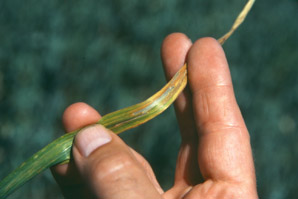 |
| Cereal leaf beetle feeding damage is evident in the semi transparent strips on leaves. Photo By Bruce Barker. |
“The cereal leaf beetle was first discovered in southern Alberta in 2005, by the staff of the Southern Applied Research Association Field School in some of their plots,” says Dr. Lloyd Dosdall, Associate Professor, Agricultural Entomology at the University of Alberta. Later in 2005 beetles were found in the counties of Taber and Lethbridge.
“This prompted a second survey in 2006 to determine how widespread the beetle had become and whether or not it had successfully overwintered. We found populations at about 15 sites in southern Alberta in the 2006 survey, which included one survey in late June and a second at the end of July.” The beetles were not very abundant at those sites, and in the second survey most collections comprised only a single larva per 50 sweeps, with the greatest recorded density at three larvae per 50 sweeps. A subsequent survey in 2007 found cereal leaf beetles at only six locations, however the beetles were very abundant in those locations.
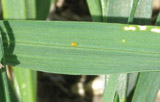 |
| Cereal leaf beetle egg along the mid-vein on the upper side of the leaf. Photo Courtesy Of L. Dosdall, University Of Alberta. |
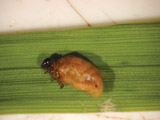 |
| Larvae of the parasitoids inside abdomen of cereal leaf beetle larvae. Photo Courtesy Of T. Larson, AAFC. |
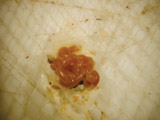 |
| Larvae of wasp parasitoid (Tetrastichus julis) recently emerged from cereal leaf beetle larvae. Photo Courtesy Of T. Larson, AAFC. |
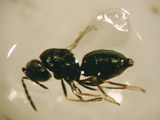 |
| Adult wasp parasitoid (Tetrastichus julis). Photo Courtesy Of T. Larson, AAFC. |
Dosdall notes that so far, the cereal leaf beetle has not expanded its range very extensively, but it could pose a serious threat to the cereal industry. Prior to the beetle arriving in Canada, Dr. Owen Olfert at Agriculture and Agri-Food Canada (AAFC) in Saskatoon conducted a study using a model based on climatic and ecological requirements of the species to determine the suitability of western Canada for the cereal leaf beetle and the potential risks. His model results showed that if the beetle arrived on the prairies, it would be capable of surviving and causing damage throughout most of western Canada, presenting a significant risk to cereal production.
Although the cereal leaf beetle has a preference for oats and barley, it will feed on any cereal crop or cultivated forage grass stand. The cereal leaf beetle has a one year life cycle, overwintering in shelterbelt areas as an adult beetle. The adults emerge very early in the spring and will feed on any available grass or cereal. They mate in the spring and lay their eggs on the upper surfaces of leaves, usually on the flag leaf of cereal crops. Their preference for the flag leaf is the real reason for concern of potential yield losses.
“The eggs, which are easy to see, are soft, oval and orange coloured,” says Dosdall. The cereal leaf beetle usually lays one or two eggs per leaf, along the mid-vein of the upper side of the leaf. The larvae hatch in about a week and feed for three weeks, which is the stage where the real risk of damage occurs. The larvae have an unusual habit of camouflaging themselves with their own feces, protecting them from birds and other potential predators. When the larval stage is completed, they drop to the ground and pupate in the soil. After two to three weeks, the new adult beetles emerge, feeding for a few more weeks before finding wintering sites.
Yield losses in the US have been estimated at 55 percent in spring wheat, 23 percent in winter wheat and 75 percent in oats and barley when fields are not treated with insecticide or other control agents. To-date, there are no registered control products for cereal leaf beetles in western Canada. However, there appears to be a very good opportunity for biological control. “The good news is the natural parasitoid for the cereal leaf beetle has arrived with it,” says Dosdall. “However, we still have a lot of questions about survival, dispersal and populations that will control the beetle.”
Dr. Hector Cárcamo, Research Scientist with AAFC in Lethbridge, is studying the natural parasitoids of the cereal leaf beetle, and is using past research and experience of the north-western US and the Creston Valley of British Columbia. “The cereal leaf beetle has a history of control by natural parasitoids in other parts of Canada and the US where they have been able to manage these insects with minimal pesticide use by using natural enemies,” explains Cárcamo.
“We were pleased to have discovered populations of the parasitoids in the same fields with the cereal leaf beetle in southern Alberta.” Cárcamo and Dosdall have also done some work in the Creston Valley of British Columbia and confirmed that the parasitoids released there in 2002 by British Columbia entomologist Hugh Phillip have established, providing a source for relocation if required. The most common parasitoid is a parasitic wasp (Tetrastichus julis).
“The US has created protected areas called nurseries to monitor and enhance populations of parasitoids to control cereal leaf beetles,” explains Cárcamo. “We began establishing a nursery in Lethbridge in the fall of 2005 by seeding winter wheat, and then seeding oats
and spring wheat in the spring of 2006. The nursery provides us with the opportunity to study and monitor both the cereal leaf beetle and its natural biological enemies.”
To be able to control an insect with biological control agents, it is necessary to have a good idea of the basic biology of the pest. At the nursery site, Cárcamo and his team are monitoring when the adult cereal leaf beetle appears, which crops it is using, the timing of the various immature stages, including the eggs and larvae, and to measure densities of insects.
“So far, the numbers of cereal leaf beetles have not been that high and are below the levels considered economical,” says Cárcamo. “If we are fortunate, we may be able to increase the parasitoid levels enough to prevent the cereal leaf beetles from reaching economic thresholds.” In the US, one larvae per flag leaf is considered the economic threshold. Cárcamo and Dosdall are prepared, should the beetle become abundant enough to determine whether this threshold is similar in Canada, to investigate the relationships between insect densities, plant damage and yield losses.
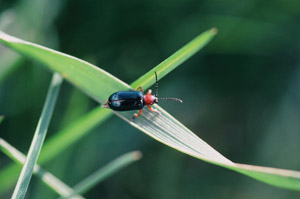 |
| Cereal leaf beetle adult. Photo Courtesy Of L. Dosdall, University Of Alberta. |
For now, researchers continue to monitor the cereal leaf beetle and the parasitoids. “The key for growers is to ‘know your enemy’ and learn to be able to identify and scout for cereal leaf beetle,” says Dosdall. “Monitoring and watching is extremely important, and sweep netting is a simple and easy method to count larvae.” The eggs and larvae are very easy to see, which makes monitoring fairly easy.
“If growers find cereal leaf beetles and they are common enough, then they should contact us and we can work with them to relocate the parasitoids to their area,” says Cárcamo. “We also encourage growers to minimize the amount of insecticides in those areas, so we can protect the parasitoids and give them a chance to increase enough to control the cereal leaf beetles.” Researchers are trying to determine the timing of adult parasitoids because if growers can avoid spraying at that time, there is a better chance of protecting them. With populations at the Lethbridge nursery, and an available source in the Creston Valley, researchers are hopeful biological control will be the answer.
Growers should continue with good agronomic practices, including diverse crop rotations. Even though the cereal leaf beetle adults move around, implementing good crop rotations and including field pea or canola can help to manage the long-term populations of the cereal leaf beetles. In areas infested with cereal leaf beetle, hay and forage movement requires a CFIA permit to show good practices to prevent accidental spread of the cereal leaf beetle.
“We have some encouraging results this year, however, none of us feel we are out of the woods yet,” says Dosdall. “Cereal leaf beetle still deserves serious consideration given the economic importance of the cereal industry, and we need to keep a close watch on how it develops.” -end-